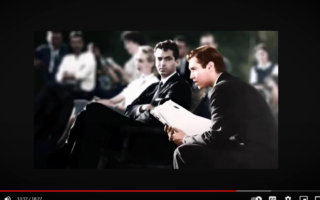John Dee (1527–1609) was an influential English mathematician, astrologer, alchemist, philosopher, and occultist. A polymath, Dee played a pivotal role in shaping the intellectual and esoteric thought of the Renaissance, combining science and mysticism in ways that reflected the time’s quest for knowledge.
Key Aspects of John Dee’s Life and Work
- Mathematics and Navigation
- Dee was a skilled mathematician and advocated for the advancement of English exploration.
- He worked with navigators, including those involved in the early British efforts to discover new trade routes, influencing the age of exploration. Dee even trained explorers such as Sir Francis Drake.
- He promoted the use of astronomy and mathematics for navigation and was associated with the creation of maps and charts, helping England plan overseas expansion.
- Astrology and Occult Interests
- In Dee’s time, astrology and science were closely intertwined. Dee served as a court astrologer to Queen Elizabeth I. He selected the date of her coronation in 1559 and advised her on various matters through astrological consultation.
- Dee also believed in alchemy, the transformation of matter, and engaged in efforts to uncover the deeper spiritual and material workings of the universe.
- Occult Studies: Enochian Magic and Angelic Communication
- Dee is well known for his attempts to communicate with angels through a practice he called Enochian magic. He worked closely with Edward Kelley, a medium who claimed to help Dee contact angels and other spiritual entities.
- They recorded the supposed conversations with these entities in special “angelic” or Enochian languages, which Dee believed were keys to divine knowledge and cosmic secrets. These occult studies had a lasting impact, influencing later mystical movements, including modern ceremonial magic and the Hermetic Order of the Golden Dawn.
- Philosophy and Esoteric Thought
- Dee’s philosophy blended elements of Christianity, Hermeticism, and Neoplatonism. He sought to unlock hidden truths about the universe, seeing science, magic, and theology as interconnected disciplines.
- Dee was also fascinated by the idea of a unified world knowledge, which he termed the “Monas Hieroglyphica” — a mystical symbol he created that he believed encapsulated the fundamental unity of all creation.
- Political Influence and Imperial Vision
- Dee had a political role, too, coining the term “British Empire” and advising Queen Elizabeth I on how to expand England’s influence. He was both a trusted advisor and a controversial figure, seen as wise by some and dangerous by others due to his interest in the occult.
- Later Life and Legacy
- In his later years, Dee’s fortunes declined. He lost favor at court and struggled financially, living in relative obscurity. He died in 1609, leaving behind a vast body of work that was both scientific and mystical.
- Despite the setbacks of his later life, Dee’s contributions lived on, influencing fields as diverse as mathematics, navigation, esotericism, and Renaissance occult traditions.
Today, John Dee is remembered as a complex figure, bridging science and mysticism at a time when the two were closely intertwined. His Enochian system of magic remains a major influence in occult circles, and his life continues to inspire books, films, and historical studies.


John Day (Dee) (Alford) (the Conjuror) (14th Great-Grandfather)
(13 July 1527 – 1608 or 1609)
| Born | 13 July 1527[3] Tower Ward, London, England[3] |
|---|---|
| Died | December 1608 or March 1609 (aged 81) Mortlake, Surrey, England |
| Alma mater | St John’s College, Cambridge Louvain University |
| Known for | Advisor to Queen Elizabeth I |
| Spouse(s) | Katherine Constable Jane Fromond |
The Arch-Conjuror of England: John Dee – A Review
Firstly, I would like to suggest that if and when I am named the arch-conjuror of the United States, or a particular state, or perhaps even the local Starbucks, I would prefer it to be done so without the hyphen. “Archconjurer” just seems tidier to me; but then again, arch-nemesis is hyphenated, so there’s the counterpoint to my own argument. Or should it be a “counter-point”? Either way, someone had better conjure up an iced grande skinny vanilla latte, no whip, or there will be hell to pay.
I just finished up Glyn Parry’s work ‘The Arch-Conjuror of England: John Dee”. I was very excited about this book, firstly because I had to get it all the way from England, or rather all the way from Amazon.uk which makes me feel like the consummate occult hipster (at least outside of the UK), and secondly because it was about John Dee, about whose work I wrote a little bit about some time back. Furthermore, the author is from New Zealand, which country I was in while finishing up the last edits on the aforementioned work, The Magic Seal of Dr. John Dee, The Sigillum Dei Aemeth. I mean, what are the odds? I was meant to read this book – nothing short of Divine providence, I tell you!
And read it, I did. Now, readers be warned, this is not a book like most books on Dee that follow his career in conjuration, exposing all the minute details of his magical system that continue to baffle a number of us well past the point of insanity. There are no speculations on odd lettering or table construction, his seemingly endless dependency on the letter ‘b’, or what Angelic Governors might rule over IP address sub-domains of the World Wide Web.
This book is different: it’s about politics, especially the red-state/blue-state conflict of the era, the Reformation, and Counter-Reformation that set the stage for the reign of Queen Elizabeth I. This conflict would include, of course, the treatment of “popish” – that’s “Pope-ish” – witchcraft and conjuring, bringing Dee right into the midst of the milieu.
While a number of books from magically-inclined authors have noted political machinations as a side-note to the magical work of Dr. Dee, this work does us all the exceptional favor of looking at it from the other direction. Its focus is on the politics and intrigue of Tudor England from the time surrounding Dee’s birth through to his death in 1609. (Parry actually provides a reference to external documents showing Dee died in 1609, and not in 1608, about which there has been some debate given the absence of Dee’s diary entries past the earlier of the two dates.)

Magic is thus relegated to the side-plot, though not entirely, as its involvement and/or utility in court matters (royal, not legal) was often the measure of Dee’s fleeting successes and failures. It also focuses on his much-overlooked work with alchemy, usually deemed to be Kelley’s forte, but only because the latter seems to have been the more successful promoter of his efforts.
Those of us that have studied Dee know that he was at least at times close to Queen Elizabeth and had the pleasurable acquaintance of many in the upper echelons of the Elizabethan court. However, Dee’s own diaries do not give us much insight into the background of these interactions, nor the many political ramifications that might precede or promote them. Parry’s book does so marvelously, detailing the plots, sub-plots, twists, and deceptions behind the national and international political climates of the time.
So, if you are looking for work on the magic of Dr. Dee, this is not it. There are a few of those about, however, and a quick search on certain online auction sites can quickly part you from a great deal of your money should you choose to pursue some of them. (There are also a number of them readily available that can do so for a much more reasonable price.) However, if you are looking for a fantastic book on the politics underlying and informing the magical work of John Dee, then this is definitely the book. I am glad to have made the purchase.
Sincerely,
Colin Campbell, Arch-Reviewer of New England

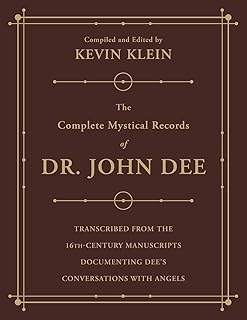
The Complete Mystical Records of Dr. John Dee (3-volume set): Transcribed from the 16th-Century Manuscripts Documenting Dee’s Conversations with Angels
by Kevin Klein
The Most Faithful and Accurate Edition of John Dee’s Conversations with Angels
An Incomparable Treasure Ten Years in the Making
Now available in a three-volume paperback set, this is a must-have treasure for Dee aficionados and esoteric scholars who absolutely need the most meticulously detailed version of these highly influential works. A labor of love ten years in the making, these volumes include transcripts of four manuscripts from the British Library and one from the Bodleian Library in Oxford. Two of these manuscripts are only available in this set. Each page is laid out to match the original manuscripts, including lines, marks, notations, lacunae, and diagrams.
In these volumes, the breadth of content, the level of detail, and the fidelity to the originals is unmatched. John Dee’s original writings have never been presented in such an immaculate fashion, free of the typos, oversights, and omissions that have previously plagued serious Dee scholarship.

This complete, 1,760-page work also includes folio numbers, errata, notes, and ten comprehensive appendices to provide essential context and enhance the practical understanding of the manuscripts:
Dee’s European Journey (with map) • The Ninety-One Parts of the Earth (with maps and table) • Gazetteer • Glossary of Archaic and Obscure Words • Brief Biographical Guide • An Examination of John Dee’s 48 Claves Angelicæ • Concordance of Angelic Words in Dee’s 48 Claves Angelicæ • List of Spiritual Creatures • A Selection of Interesting Quotations • Complete Angelic Lexicon
Three paperback volumes are packaged in a premium linen-covered, foil-stamped slipcase. This is the deluxe paperback edition of the sold-out limited-edition hardcover set (9780738752587).
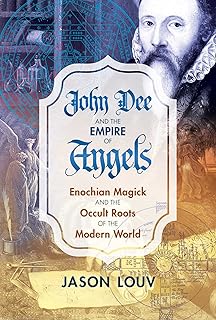
John Dee and the Empire of Angels: Enochian Magick and the Occult Roots of the Modern World
by Jason Louv
A comprehensive look at the life and continuing influence of 16th-century scientific genius and occultist Dr. John Dee
• Presents an overview of Dee’s scientific achievements, intelligence, and spy work, imperial strategizing, and his work developing methods to communicate with angels
• Pieces together Dee’s fragmentary Spirit Diaries and examines Enochian in precise detail and the angels’ plan to establish a New World Order
• Explores Dee’s influence on Sir Francis Bacon, modern science, Rosicrucianism, and 20th-century occultists such as Jack Parsons, Aleister Crowley, and Anton LaVey
Dr. John Dee (1527-1608), Queen Elizabeth I’s court advisor and astrologer, was the foremost scientific genius of the 16th century. Laying the foundation for modern science, he actively promoted mathematics and astronomy as well as made advances in navigation and optics that helped elevate England to the foremost imperial power in the world. Centuries ahead of his time, his theoretical work included the concept of light speed and prototypes for telescopes and solar panels. Dee, the original “007” (his crown-given moniker), even invented the idea of a “British Empire,” envisioning fledgling America as the new Atlantis, himself as Merlin, and Elizabeth as Arthur.
But, as Jason Louv explains, Dee was suppressed from mainstream history because he spent the second half of his career developing a method for contacting angels. After a brilliant ascent from star student at Cambridge to scientific advisor to the Queen, Dee, with the help of a disreputable criminal psychic named Edward Kelley, devoted ten years to communing with the angels and archangels of God. These spirit communications gave him the keys to Enochian, the language that mankind spoke before the fall from Eden. Piecing together Dee’s fragmentary Spirit Diaries and scrying sessions, the author examines Enochian in precise detail and explains how the angels used Dee and Kelley as agents to establish a New World Order that they hoped would unify all monotheistic religions and eventually dominate the entire globe.
Presenting a comprehensive overview of Dee’s life and work, Louv examines his scientific achievements, intelligence, spy work, imperial strategizing, and Enochian magick, establishing a psychohistory of John Dee as a singular force and fundamental driver of Western history. Exploring Dee’s influence on Sir Francis Bacon, the development of modern science, 17th-century Rosicrucianism, the 19th-century occult revival, and 20th-century occultists such as Jack Parsons, Aleister Crowley, and Anton LaVey, Louv shows how John Dee continues to impact science and the occult to this day.
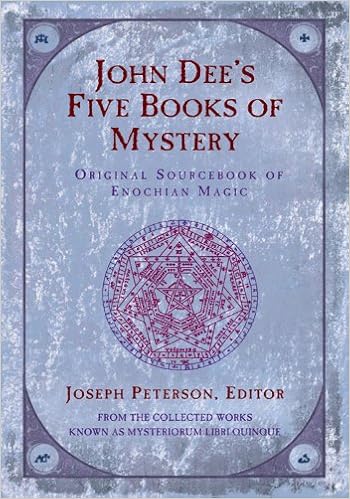
John Dee’s Five Books of Mystery: Original Sourcebook of Enochian Magic
by Joseph Peterson
Discovered in a hidden compartment of an old chest long after his death, the secret writings of John Dee, one of the leading scientists and occultists of Elizabethan England, record in minute detail his research into the occult. Dee concealed his treatises on the nature of humankind’s contact with angelic realms and languages throughout his life, and they were nearly lost forever. In his brief biography of John Dee, Joseph Peterson calls him a “true Renaissance man”? detailing his work in astronomy, mathematics, navigation, the arts, astrology, and the occult sciences. He was even thought to be the model for Shakespeare’s Prospero.
All this was preparation for Dee’s main achievement: five books revealed and transcribed between March 1582 and May 1583, bringing to light mysteries and truths that scholars and adepts have been struggling to understand and use ever since. These books detail his system for communicating with the angels and reveal that the angels were interested in and involved with the exploration and colonization of the New World, and in heralding in a new age or new world order. While Dee’s influence was certainly felt in his lifetime, his popularity has grown tremendously since. His system was used and adapted by the Hermetic Order of the Golden Dawn, and subsequently by Aleister Crowley.
This new edition of John Dee’s Five Books of Mystery is by far the most accessible and complete published to date. Peterson has translated Latin terms and added copious footnotes, putting the instructions and references into context for the modern reader.
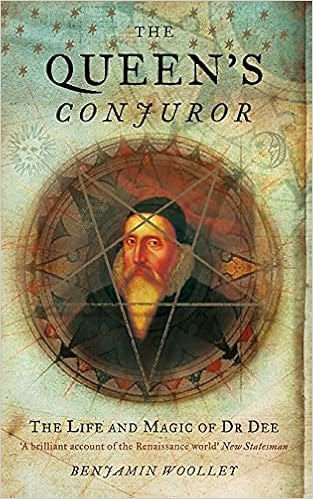
The Queen’s Conjuror: The Life and Magic of Dr. Dee (Science and Magic of Dr Dee)
Part of: Science and Magic of Dr. Dee
A spellbinding portrait of Queen Elizabeth’s conjuror – the great philosopher, scientist and magician, Dr John Dee (1527–1608) and a history of Renaissance science that could well be the next ‘Longitude’.
John Dee was one of the most influential philosophers of the Elizabethan Age. A close confidant of Queen Elizabeth, he helped to introduce mathematics to England, promoted the idea of maths as the basis of science, anticipated the invention of the telescope, charted the New World, and created one of the most magnificent libraries in Europe. At the height of his fame, Dee was poised to become one of the greats of the Renaissance. Yet he died in poverty and obscurity – his crime was to dabble in magic.
Based on Dee’s secret diaries which record in fine detail his experiments with the occult, Woolley’s bestselling book is a rich brew of Elizabethan court intrigue, science, intellectual exploration, discovery and misfortune. And it tells the story of one man’s epic but very personal struggle to come to terms with the fundamental dichotomy of the scientific age at the point it arose: the choice between ancient wisdom and modern science as the path to truth.
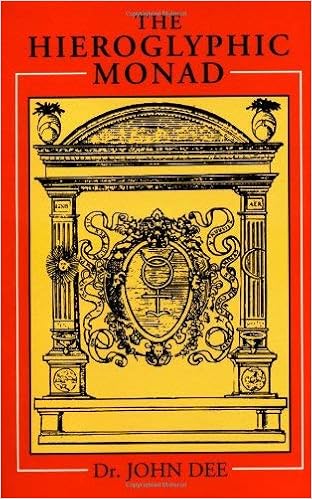
The Hieroglyphic Monad
by John Dee et al
Written in thirteen days in 1564 by the renowned Elizabethan magus, Dr. John Dee, The Hieroglyphic Monad explains his discovery of the monas, or unity, underlying the universe as expressed in a hieroglyph, or symbol. Dee called The Hieroglyphic Monad a “magical parable” based on the Doctrine of Correspondences which lies at the heart of all magical practice and is the key to the hermetic quest. Through careful meditation and study of the glyph, its secrets may be slowly revealed.
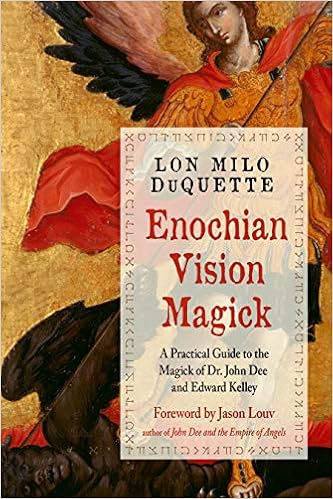
Enochian Vision Magick: A Practical Guide to the Magick of Dr. John Dee and Edward Kelley
by Lon Milo DuQuette and Jason Louv
Having mastered the arts and sciences of his age, Elizabethan magus Dr. John Dee (1527–1608) resolved that worldly knowledge could no longer provide him the wisdom he desired, and as did so many other learned men of the day, he turned his attention to magick. In 1582 he and his clairvoyant partner Edward Kelley made magical contact with a number of spiritual entities who identified themselves as angels―the same that communicated with Enoch and the patriarchs of the Old Testament. Over the next 3 years they revealed to Dee and Kelley three distinct magical systems of vision magick. The third and last of these incorporated a series of “calls” to be recited in an angelic language in order to raise the consciousness of the magician to a level where angelic contact is possible.
In Enochian Vision Magick, Lon Milo DuQuette introduces the origins of Enochian magick and offers the expert and novice alike the opportunity not only to see the big picture of the full system but also the practical means by which he or she can become attuned in the same step-by-step manner that first prepared Dee and Kelley.
First published by Weiser in 2008, this new edition includes a new introduction and new back matter by the author as well as a new foreword by Jason Louv.
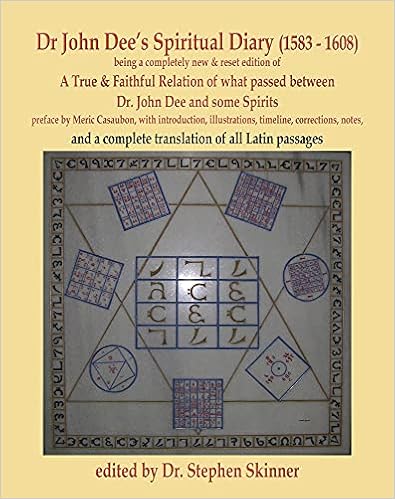
Dr. John Dee’s Spiritual Diary (1583-1608): Second Edition
by Dr. Stephen Skinner
In this updated edition of a classic John Dee resource, Dr. Stephen Skinner has added more than 100 pages of translated text so those who don’t know Latin can read the fascinating chronicle of Enochian magick from beginning to end entirely in English. With an 8″ x 10″ trim size―decreased from the first edition’s large-size folio format―this exceptional second edition will be a welcome addition to the enthusiast’s shelves. This edition retains the impeccable scholarship of the first edition, which was the first corrected, updated, reader-friendly version of A True & Faithful Relation of what passed for many years between Dr. John Dee… and some Spirits, transcribed and prefaced by Meric Casaubon in 1659. This edition also retains the detailed introduction, appendices, extensive footnotes, supplementary texts, additional illustrations, Dee timeline, and much more.
This is the second edition of the corrected, reorganized, fully annotated book of Dr. John Dee’s fascinating diaries and writings, which chronicle in stunning first-person detail Dee’s invocation of the angels and the reception of their Enochian system of magick, his experiments in alchemy, and experiences in the courts of the crowned heads of Europe.
The Enochian Evocation of Dr. John Dee
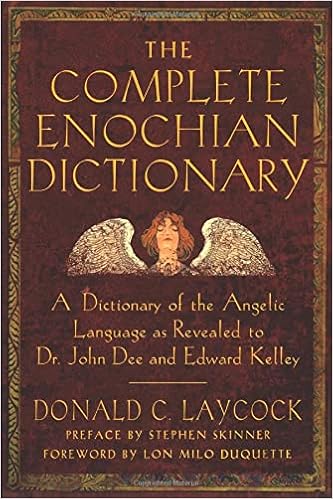
Complete Enochian Dictionary: A Dictionary of the Angelic Language As Revealed to Dr. John Dee and Edward Kelley
by Donald C Laycock, Edward Kelly, et al.
The essential reference for understanding the Enochian language (“the language of the angels”), the proper pronunciation of the letters of the Enochian alphabet, and the use of Enochian evocations to call forth celestial beings.
In 1581, Dr. John Dee, an advisor in the court of Queen Elizabeth I, began a series of experiments intended to explore the ability to contact the spirit world. With Edward Kelley acting as the medium in these experiments, Dee was able to record these communications as they were transmitted in Enochian, the language of the angels. Dr. Dee’s efforts furthered the development of the Enochian system of magic, and his methods of invocation have been taken up and expounded upon by many magicians since.
Donald C. Laycock has thoroughly analyzed the work of Dee and Kelley. In this volume, he recounts the history of their experiments. He provides a pronunciation guide for the twenty-one letters, significant to untangling both the meaning and the derivation of the messages handed down from Dee and Kelley, and an essential Enochian/English and English/Enochian dictionary. The result is a fascinating linguistic and magical mystery story, integral to any study of the Enochian tradition.
This new edition of Laycock’s work includes a lucid preface by Stephen Skinner that sets the tone and historical context for today’s readers. Lon Milo DuQuette foreword gives us a humorous, yet the edifying, description of how he and his students put The Complete Enochian Dictionary to the test with astonishing results. This book is a must-have for any serious magician’s library.

Sacred Symbol of Oneness by John Dee of London: An English translation of John Dee’s 1564 Monas Hieroglyphica, which was written in Latin
by John Dee and James Alan Egan offers)
This English translation of John Dee’s Monas Hieroglyphica is a companion piece to John Dee’s original Latin, published by James Alan Egan. As some of John Dee’s cryptic clues get “lost in translation,” it’s useful to study both versions. To simplify cross-referencing, this English translation mirrors the layout and design of the original Latin version. In other words, both this translation and the original have the “feel” of John Dee’s original work except for a few minor differences. Dee’s original, printed in Antwerp in 1564, had a “stapled binding” whereas this version has a “perfect binding” (with a spine). Also, the cover of the original Latin version the same thickness as the paper stock of its interior pages.
![The Private Diary of Dr. John Dee And the Catalog of His Library of Manuscripts by [John Dee, J. O. (James Orchard) Halliwell-Phillipps]](https://m.media-amazon.com/images/I/51RwecR2ngL._SY346_.jpg)
The Private Diary of Dr. John Dee And the Catalog of His Library of Manuscripts
by John Dee and J. O. (James Orchard) Halliwell-Phillipps
This book was converted from its physical edition to the digital format by a community of volunteers. You may find it for free on the web. Purchase of the Kindle edition includes wireless delivery.





















A Painting of John Dee, Astrologer to Queen Elizabeth I, Contains a Hidden Ring of Skulls
The life and work of John Dee contained a strange mix of science and magic
/https://tf-cmsv2-smithsonianmag-media.s3.amazonaws.com/filer/df/58/df58fb35-c3b8-4fe2-8ade-c90cce3e8171/1280px-glindoni_john_dee_performing_an_experiment_before_queen_elizabeth_i.jpg)
A Victorian-era oil painting by artist Henry Gillard Glindoni captures one of the most enigmatic figures of Elizabethan England. In Glindoni’s piece, Queen Elizabeth I sits in an elevated chair, surrounded by courtiers clothed in sumptuous fabric and the extravagant white neck ruffs of the time. All are peering with interest at the tall, black-robed figure of a man holding a vial over a small fire in a brazier by his feet.
The figure is John Dee, the Queen’s advisor and astrologer; a man who mixed science and the occult and believed he spoke to angels. The painting captures some of the intrigue and allure Dee held, but x-ray imaging commissioned for the Royal College of Physicians’ new exhibition, “Scholar, courtier, magician: the lost library of John Dee,” reveals just how unsettling his reputation became — it shows that Glindoni first painted Dee surrounded by a ring of human skulls, reports Mark Brown for the Guardian.
The Royal College of Physicians’ exhibition, which opens today and will run through June 29, also includes more than 100 books in Dee’s collection, which only covers a fraction of his massive library.
“He is one of Tudor England’s most interesting and enigmatic figures and we are exploring that without coming down with a view on whether he is a scholar, courtier or magician,” the exhibition’s curator, Katie Birkwood, tells the Guardian. “He is all of those and more.”
https://2c4d279b5139ec55751df489cc5693b7.safeframe.googlesyndication.com/safeframe/1-0-40/html/container.htmlReport this ad
Dee’s library once held more than 3,000 books, writes Sophie Beckwith for Culture24, but many were stolen and sold when Dee traveled through Europe. His collection included tomes on love, history, astrology, alchemy and more, a demonstration of the breadth of his interest. Many of the books in the exhibit have notes in Dee’s own hand. One book on mathematics has a Latin inscription describing Dee’s stay in “the house of my singular friend,” a reference to the period Dee spent under house arrest with Edmund Bonner, the bishop of London. He was placed there after a letter he wrote to Elizabeth, predicting that Queen Mary Tudor I’s reign would soon end, was intercepted by Mary’s spies.
Though Dee escaped charges of treason, he was sent to Bishop Bonner’s, a man known for his ruthlessness toward heretics. Whether the men did get along, or whether Dee was being sarcastic in his inscription, we cannot know, Birkwood tells the Guardian. But when Elizabeth did take the throne, Dee found favor in her court.
For a time, he was “considered one of the most learned men in Europe,” writes Jason Louv in his book, The Angelic Reformation: John Dee, Enochian Magick & the Occult Roots of Empire, excerpted at BoingBoing. As Louv details in his book, Dee translated Euclid’s, Elements and so introduced the English-speaking world to the +, -, x and ÷ signs. So influential was Dee that Shakespeare created Prospero in The Tempest, based on him. The Bard had reason to be inspired by the mysterious figure: Dee also helped create the British intelligence service and signed his secret letters to Elizabeth with two circles, representing eyes, and the number seven, the alchemist’s lucky number, writes Peter Gentle for The World of English. Centuries later, Ian Fleming would read about Dee’s life and give his own creation, James Bond, the “007” code name.Report this ad
Yet Dee also believed he could speak to angels using a scrying mirror made of black obsidian, wrote a new language—one which he believed was spoken by angels—and traveled throughout Europe with Edward Kelley, the scryer who saw the angels, Louv writes in his book. Those actions would gain him enemies in the Catholic Church.
After Elizabeth died, scholars would paint Dee as a deluded fool. It’s that legacy that may have inspired Glindoni to add the skulls to his painting, perhaps along with the Victorian-era obsession with death. But why did he then paint over them? Birkwood tellsthe Guardian that the patron who asked for the painting probably found them too unnerving.Report this ad
“Glindoni had to to make it look like what we now see, which is august and serious, from what it was, which was occult and spooky,” she says. “That epitomises the two different impressions of Dee which people have and the fight between them.”
If nothing else, this new finding on Glindoni’s oil painting proves that even centuries after his death, the Queen’s conjurer still has the ability to enthrall us with his work.


